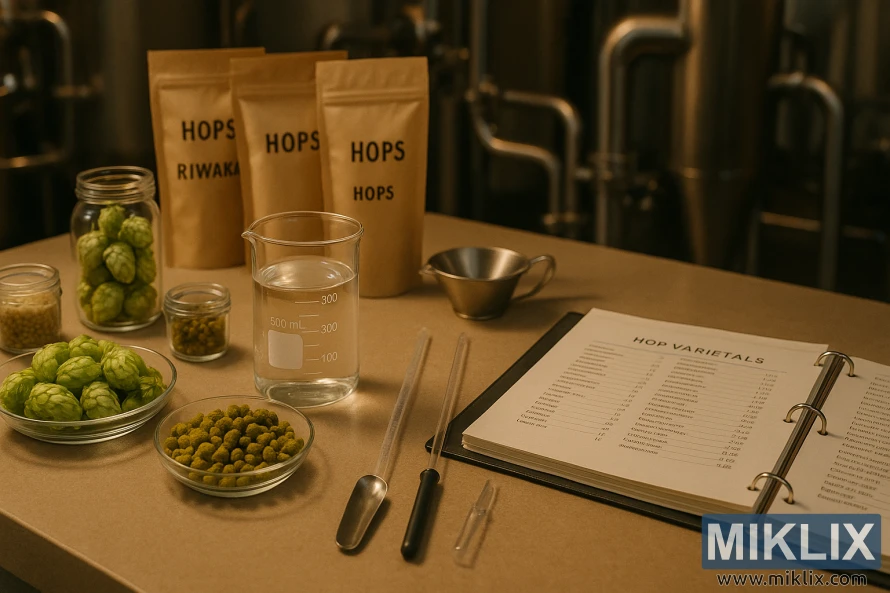Image: Brewery Counter with Riwaka Hops and Brewing Tools
Published: October 22, 2025 at 9:50:40 PM UTC
An organized brewery counter displays fresh Riwaka hop cones, hop pellets, grains, and brewing tools alongside a beaker of water and a hop varietals binder. Warm lighting highlights the precision and craft of brewing with hops.
The photograph captures a meticulously arranged brewery counter, presenting an atmosphere that seamlessly blends scientific precision with artisanal dedication. The warm, diffused lighting creates a soft golden glow, casting gentle highlights and shadows across the workspace. The centerpiece of the scene is a glass beaker filled with crystal-clear water, its transparent clarity reflecting the ambient light and symbolizing the purity required in the brewing process. Beside it lies an assortment of brewing tools—pipettes, measuring spoons, and a stainless-steel funnel—signifying the technical care that goes into crafting exceptional beer.
Surrounding the beaker, an array of hop forms emphasizes both variety and preparation. To the left, fresh Riwaka hop cones sit vibrantly green in a clear glass jar and in a shallow bowl, their textured, layered bracts full of natural oils. Adjacent to them are smaller jars and bowls containing hop pellets, neatly rounded and earthy in tone, as well as pale malt grains—a visual reminder of the symbiotic ingredients that define brewing. The arrangement is deliberate, almost ceremonial, showcasing each element with clarity while reinforcing the notion that beer is both science and art.
Behind the ingredients, kraft paper bags labeled simply “HOPS” and “RIWAKA” stand upright, evoking both practicality and a rustic sense of authenticity. Their minimalistic typography directs focus to the product itself, underscoring its identity as the star of the brewing process. The bags form a vertical backdrop to the low, detailed display of cones, pellets, and grains, anchoring the image compositionally.
To the right, a large open binder titled “HOP VARIETALS” provides a sense of methodical study and reference. Its neatly printed columns of hop names and specifications give the impression of a brewer or researcher consulting varietal data, perhaps comparing oil content, alpha acids, or flavor notes before making a brewing decision. The binder adds intellectual depth to the scene, reinforcing the sense that great beer arises not only from creativity but also from accumulated knowledge and disciplined practice.
In the background, blurred but discernible stainless-steel brewing equipment looms—tanks, pipes, and fixtures—all softly out of focus. Their presence contextualizes the scene: this is not merely a static laboratory display but an active brewing space, where experimentation, refinement, and production intersect. The combination of technical tools, natural hops, and industrial infrastructure brings together three dimensions of brewing: the organic, the precise, and the industrial.
The overall mood is one of harmony between craft and science. The hops and grains connect the viewer to agriculture and terroir, the pipettes and beaker suggest scientific rigor, and the binder conveys knowledge and tradition. The subdued yet inviting lighting heightens the sense of calm focus, inviting the viewer into a world where patience and detail transform simple ingredients into a beverage of complexity and joy. This image is not only about ingredients laid on a counter—it is about reverence for the brewing process itself, about honoring the union of precision and passion, and about capturing the subtle artistry behind every glass of craft beer brewed with Riwaka hops.
The image is related to: Hops in Beer Brewing: Riwaka

